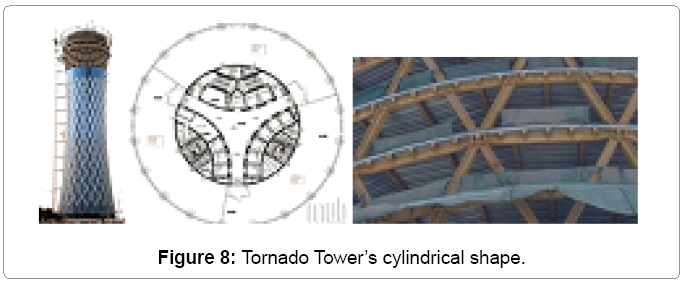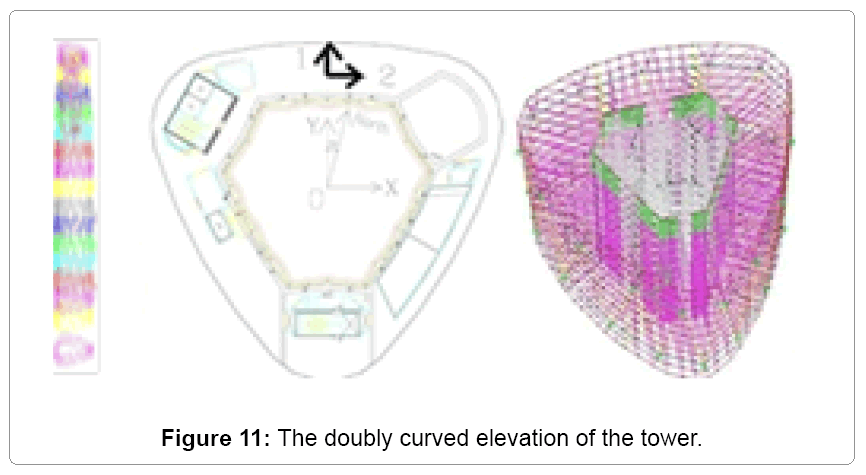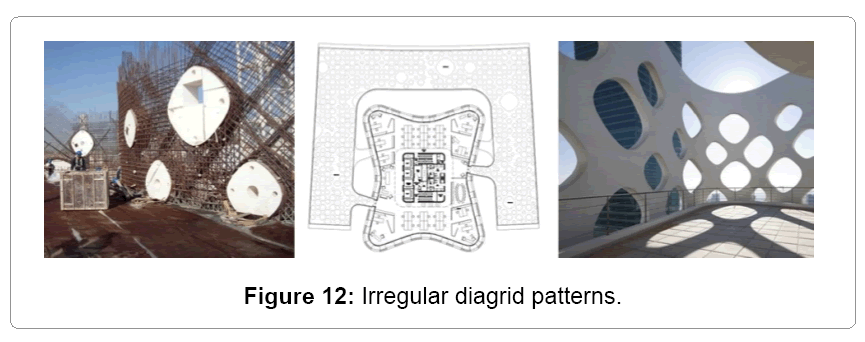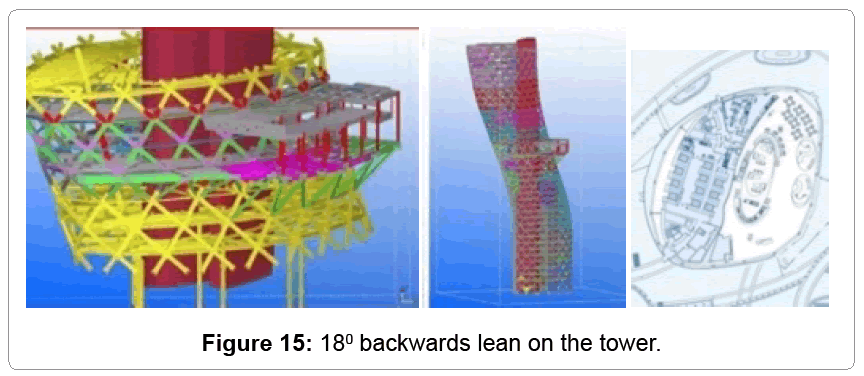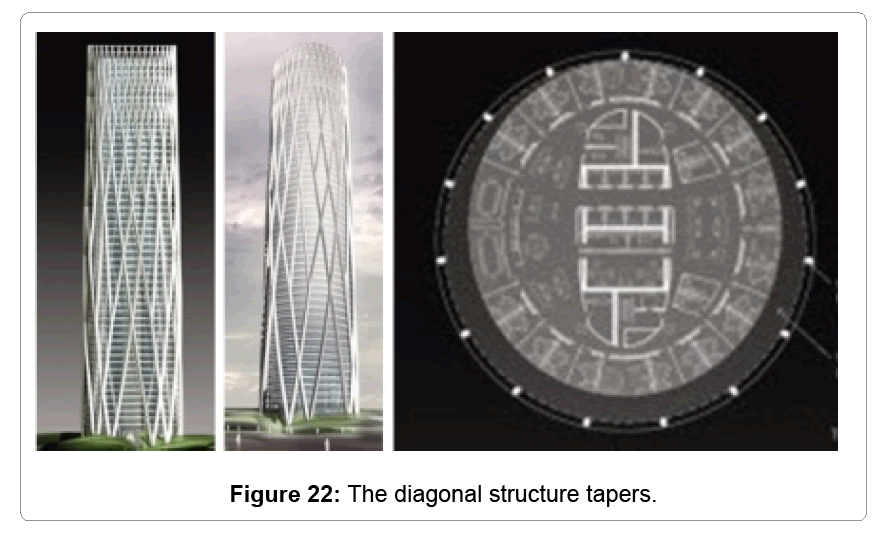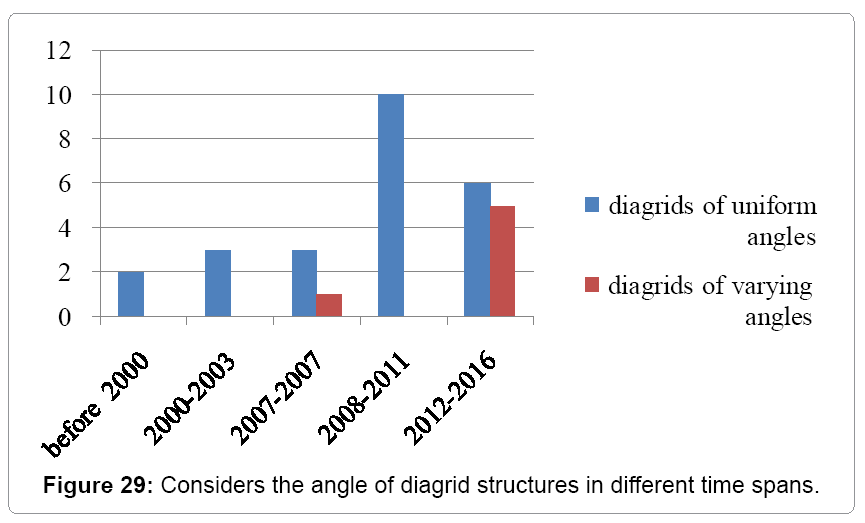Research Article Open Access
The Evolutionary Process of Diagrid Structure Towards Architectural, Structural and Sustainability Concepts: Reviewing Case Studies
Sepideh Korsavi1* and Mohammad Reza Maqhareh21Master Student, Art and Architecture faculty, Shiraz University, Iran
2Associate Professor, Art and Architecture faculty, Shiraz University, Iran
- *Corresponding Asuthor:
- Sepideh Korsavi
Master Student, Art and architecture faculty
Shiraz University, Iran
Tel: 98(711)628419
Fax: 98(711)2332227
E-mail: sepidehkorsavi@gmail.com
Received February 25, 2014; Accepted March 10, 2014; Published March 17, 2014
Citation: Korsavi S, Maqhareh MR (2014) The Evolutionary Process of Diagrid Structure Towards Architectural, Structural and Sustainability Concepts: Reviewing Case Studies. J Archit Eng Tech 3:121. doi:10.4172/2168-9717.1000121
Copyright: © 2014 Korsavi S, et al. This is an open-access article distributed under the terms of the Creative Commons Attribution License, which permits unrestricted use, distribution, and reproduction in any medium, provided the original author and source are credited.
Visit for more related articles at Journal of Architectural Engineering Technology
Abstract
Recently the use of perimeter diagonals which resist lateral forces and carry gravity loads simultaneously without vertical columns has increased significantly and are known as ‘diagrid’. This structure is made up of diamond modules with diagonal members and provides more lateral stiffness compared to the conventional structures. Generally, these structures have provided the context for more elegant designs and more efficient structures, making them so popular among architects and engineers. Consequently, these structures have made significant advances during the last decade although they are regarded as a totally new trend. The paper aims at discovering the evolutionary process of diagrid structures and their progresses which leads to major breakthroughs in architectural, structural and sustainability concepts. Indeed, these recent advances are investigated and reported for architects and engineers. The results, based on case studies, show that these structures have been able to address most of the designing requirements. They have also been used in different projects with totally different heights, areas and functions, suggesting diamond modules can be applied not only for high-rises but for a wide range of projects.
Keywords
Perimeter diagonals; Diagridstructures; Architectural and structural concepts; Evolutionary process
Introduction
Recently the use of perimeter diagonals—hence the term ‘diagrid’— for structural efficiency and architectural elegance has generated renewed interest from architectural and structural designers [1]. Diagrid structures commonly utilize intersecting diagonal members instead of the conventional vertical columns as structural supporting systems [2] which give the building a recognizable aesthetic image [3]. The difference between conventional exterior-braced frame structures and current diagrid structures is that, for diagrid structures, almost all the conventional vertical columns are eliminated. This is possible because the diagonal members in diagrid structural systems can carry gravity loads as well as lateral forces due to their triangulated configuration in a distributive and uniform manner [4]. For instance, structural performance of braced tubes and diagrid structures are very similar in a sense that both systems carry lateral loads very efficiently with their structural members’ axial actions. While bending rigidity in braced tubes is provided primarily by vertical perimeter columns, bending rigidity in diagrids is provided by diagonals which also provide shear rigidity because the system is typically composed of only diagonals [5]. Indeed, the diagrid systems are the evolution of braced tube structures with mega-diagonal members diffusely spread over the façade [6]. In addition, by using diagonals, diagrid structures use a lesser amount of structural material in general than conventional structural systems composed of orthogonal members [2]. Indeed, the structural efficiency of the diagrid system makes the number of interior columns decrease, therefore allowing much flexibility on the plan design. This is much preferred by architects and designers [7].
Being a diagrid, the geometry of the single module plays a major role in the internal axial force distribution, as well as in conferring global shear and bending rigidity to the building structure [8]. A diagrid’s module has a diamond shape which contains a number of stories. Modules are classified into 4 different groups including small modules (2-4 stories), mid-size modules (6-8 stories), large modules (more than 10 stories) and irregular modules [9]. Moreover, diagrid’s angle is the angle of diagonal members [10]. Modules and angles both play a key role in structural, architectural and aesthetic concepts of these structures.
Moon [1,4,10-12] is one of the researchers who has done a lot of research on diagrid structures. This paper tries to find out about the evolutionary process of diagrid structures which influences architectural, structural and sustainability concepts. To examine this process and influential factors, the paper goes through case studies and their characteristics.
Methodology
The paper has considered 30 cases of diagrid structures and their quantitative and qualitative features to find their evolutionary process, therefore these cases have been classified in the order of completion year. Each case’s data has been summarized in Table 1 and most cases’ structural concepts are discussed in the following.
| Image | Building | Location | Construction | Architect | The height or number of stories | Area(m2) | Diagrid | Module | Diagrid's angle | Reference |
|---|---|---|---|---|---|---|---|---|---|---|
 |
Shukhov Tower | Moscow | 1920-1922 | Vladimir Shukhov | 350 m | Steel grid | [13] | |||
 |
IBM Building | Pittsburgh, U.S.A | Completed in 1963 | Curtis and Davis | 13 stories 58 m |
Steel grid | 1 | [9] | ||
 |
City Hall | London | Completed in 2002 | Norman Foster | 10 stories, 45 m | 18000 | Steel grid | [14] | ||
 |
PRADA Boutique | Tokyo Japan |
2001-2003 | Herzog and de Meuron | 6 floors above ground, 2floors underground, 28 m | Steel grid | 2 | 33 | [15] | |
 |
Swiss Re | London | 2001-2003 | Foster and Partners | 40 floors, 180 m | 47950 | Steel grid | 4 | 63 | [8,16,17] |
 |
Hearst Tower | New York, USA | 2003-2006 | Foster and Partners | 46 stories, 183 m | 79500 | Steel grid | 8 | 70 | [8,17,18] |
 |
Atlas Building | Wageningen, Netherlands | Completed in 2006 | Rafael Vi├?┬▒oly Architects | 7 stories | 11000 | Concrete grid | 1 | 45 | [9,19] |
 |
The Royal Ontario Museum |
Toronto, Canada | Completed in 2006 | Daniel Libeskind | 6 stories | Steel grid | [9] | |||
 |
Poly Real Estate Headquarters | Guangzhou, China | 2004-2007 | S.O.M | 34 stories, 150 m | 180000 | Concrete grid | 6 | 54 | [20] |
 |
Vivaldi Tower | Amsterdam | 2004-2008 | Foster and Partners | 24 stories, 87 m | 30000 | Steel grid | 6 | 72 | [21] |
 |
SIPG Tower | Shanghai China | Completed in 2008 | East China | 29 stories above ground | Steel grid | 6 | [9] | ||
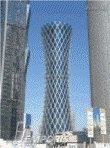 |
Tornado Tower | Doha, Qatar | 2006-2008 | C.I.C.O | 52floors above ground,3floors underground, 200m | 58029 | Steel grid | 4 | [22] | |
 |
Yellow Building | London, England | Completed in 2008 | AHMM | 7stories above, 1story underground | 15000 | Concrete grid | 4 and 5 | 61 | [23,24] |
 |
One Shelly Street Building | Sydney, Australia | 2007-2009 | Fitzpatrick partners | 7 and 11 stories | 33000 | Steel grid | 2 | [25] | |
 |
Guangzhou West Tower | Guangzhou, China | 2005-2010 | Wilkinson Eyre Architects | 103 stories, 440 m | 250095 | Concrete Filled Steel Tube | 12 | 73 | [8,26] |
 |
O-14 tower | Dubai, United Arab Emirates | Completed in 2010 | Reiser Umemoto | 24 stories, 106 m | 31400 | Concrete grid | [9,27] | ||
 |
Al Dar Headquarters | Abu Dhabi, United Arab Emirates | Completed in 2010 | MZ Architects | 23 floors above and 3 floors under ground, 110 m | 123000 | Steel grid | 8 | 60 | [28] |
 |
Hong Kong Institute of Design | Hong Kong | Completed in 2010 | CAAU | 12 stories, 52.3 m | 42000 | Steel grid | 2 | 66 | [29] |
 |
Capital Gate | Dubai | 2007-2011 | RMJM | 35 stories and 160 m | 53100 | Steel grid | 2 | [30] | |
 |
CCTV Tower | China | 2004-2012 | Rem Koolhassand OMA | 44 floors above and 3 floors under ground, 234 m | 473000 | Steel grid | irregular | [31,32] | |
 |
Doha Tower | Doha, Qatar | 2005-2012 | John Novel | 45 floors above and 4 floors under ground, 231 m | 100000 | R.C. crossing diagrid columns | 8 | 48 | [18] |
 |
The Bow Tower | Canada | 2007-2012 | Norman Foster | 59 stories, 238 m | 292000 | Steel grid | 12 | [33] | |
 |
Dorobanti Tower | Bucharest, Romania | 2008-2013 | Zaha Hadid | 57 floors above ground, 200 m | 100000 | Steel grid filled by concrete | irregular | [34] | |
 |
Cleveland Clinic | Abu Dhabi, UAE | Completed in 2013 | HDR Architecture | 473122 | Steel grid | 2 | [9,35,36] | ||
 |
Manukau Institute of Technology | Auckland New Zealand |
Completed in 2013 | Warren and Mahoney architects | 5 stories | 65000 | Steel grid | 4 | [9] | |
 |
Technosphere | Abu Dhabi, UAE | Completed in 2013 | James Law | More than 25 stories | 800000 | Steel grid | 4 | [37] | |
 |
Lotte Tower | Seoul, Korea | Completed in 2014 | S.O.M | 123 stories, 556 m | Steel grid | irregular | Varying angles from 60 to 79 | [16,38] | |
 |
West Bay Office Tower | Doha, Qatar | Completed in 2014 | S.O.M | 50 stories, 230 m | prefabricated steel and concrete “diagrid” frame | irregular | Varying angles | [39] | |
 |
Poly International Plaza | Beijing, China | Completed in 2015 | S.O.M | 31 stories, 161.2 m | 116000 | Steel grid | 4 | [40] | |
 |
Z15 Tower | Beijing, China | 2011-2016 | TFP architects | 108 stories, 528 m | 300000 | Steel grid | irregular | [9] |
Table 1: Shows each case├ó┬?┬?s data.
Structural Concepts of Case Studies
Shukhov tower
Shukhov created this free-standing steel diagrid structure with the help of a mathematician to devise the strongest structure that used the least amount of material. Figure 1 shows a hyperboloid structure (hyperbolic steel gridshell). Due to its diagrid structure, the steel shell of the Shukhov Tower experiences minimum wind load [13].
IBM building
It has integrated the diagrid with the glazing system resulting in oddly shaped windows (Figure 2). This would have created a far more expensive option than the balance of curtain wall clad office buildings of the same period, and was likely the reason for its brief use. The steel diagrid exoskeleton assists in stability and is not a classic curtain wall system [2].
PRADA boutique
This comprises a diagonal latticework frame with a façade consisting of rhombus-shaped units (Figure 3). The diagonal lattice forming the outer lattice forms the structural framework while being an integral part of the glass facade (avoiding the need for vertical or horizontal members in the vertical planes) [14-18].
Swiss Re tower
This is supported by an efficient structure consisting of a central core and a perimeter “diagrid’. Unlike conventional tall buildings in which the central core provides the necessary lateral structural stability, the Swiss Re’s core is required to act only as a load-bearing element and is free from the diagonal bracing, producing more flexible floor plates [19]. Figure 4 illustrates tower’s circular plan that widens as it rises from the ground and then tapers toward its apex. The aerodynamic form of the tower encourages wind to flow around its face, minimizing wind loads on the structure and cladding, and enables the use of a more efficient structure [19].
Hearst tower
The diagrid facade comprised of triangulated steel frame was designed to use 21% less steel than traditional buildings of it’s type. The tower sits atop a six-story cast stone base, which was designed by Joseph Urban in 1928 [20]. The main characteristic of this building is its relatively simple geometry and regular plan which is square like (Figure 5) [21].
Atlas building
Figure 6 shows the lattice façade in a double lozenge form that helps to support the entire structure. The prefabricated concrete elements of the lattice facade are placed at a distance of 70 cm from the glass and aluminium wall [19].
Vivaldi tower
It is divided into two twelve metre-wide column free towers with open, flexible floor plates. The structural steel diagrid (Figure 7) is clad in silver aluminium and is offset by opaque black panels, which reduce the definition of the individual floor levels [21].
Tornado tower
The building has a cylindrical shape (Figure 8) with a variable radius which thins out at mid height (28.8 m/19.3 m/27.8 m). Its main feature is the outer diagrid arrangement of diagonal columns and beams which give the building a unique diamond shape pattern of the cladding [22,23].
Yellow building
Early discussions and sketched ideas were followed by parametrically driven models which were able to work with the architectural and structural requirements. This design process developed a concrete exposed diagrid which wraps around the perimeter of two rectangular floorplates (Figure 9), separated by an open atrium space [24].
One Shelly Street building
Figure 10 shows the most notable exterior diagrid structure to date. The temperate climate has permitted the diagrid to exist outside of the curtain wall façade, effectively maximizing the internal leasable area [25].
Guangzhou west tower
Proposed an efficient, cost-effective composite structure, comprising a reinforced concrete inside-core working in conjunction with the perimeter CFT (Concrete Filled Steel Tube) diagrid frame, which provides both good stiffness and fire protection to the structure (Figure 11). An optimum geometry for the diagonals and the doubly curved elevation was adopted for the effective wind-resistant design of such a super tall building [26].
O-14 tower
Employs reinforced concrete diagrid as primary lateral loadresisting system. Due to the properties of concrete, the structural diagrid patterns which are directly expressed as building facade aesthetics are more fluid and irregular (Figure 12), and different from the pristine features of steel diagrids [16]. This efficiency and modulation enables the shell to create a wide range of atmospheric and visual effects in the structure without changing the basic structural form [27].
The Al Dar headquarters
It has a distinctive and innovative design, a semispherical building comprising two circular convex shaped facades linked by a narrow band of indented glazing (Figure 13). In order to solve the challenge of the façade curvature, triangular pieces of flat glass combined into diamond like shapes, came together like a puzzle working with the diagrid and the highly complex geometry of the skin [28].
Hong kong institute of design
The overall stability of the towers is ensured by a vertical steel trellis structure,“diagrid”, equipped with a conventional beam-slab floor system in reinforced concrete (Figure 14). This “diagrid” system in steel offers excellent lateral rigidity supporting both the floating platform which spans an area of 100 m×100 m and the framework of the escalator which spans a length of 60m [29].
Capital gate
Uses the strength of the diagrid to create an 180 backwards lean on the tower (Figure 15). The tower’s concrete core is more important than those in other diagrid towers whose geometries are more symmetrical in loading. Here the base module of the diagrid has been reduced to two floors to increase the stiffness of the tube. There is a substantial increase in fabrication and erection cost as a result of the decrease in repetitive design of the nodes [25].
CCTV tower
The innovative and iconic shape of the building is capitalised upon to provide its main structural support and stability system. The form warranted a primarily structural steel building, for a “light-weight” solution and enhanced seismic performance [30]. The cost of the large number of structural elements in this tower has been somewhat limited by using the structural elements to provide the facade framing and assist in resisting gravity loads from the core [31]. CCTV Headquarters is a good example with challenging shapes (Figure 16) [32]. Longer elements and bigger mesh spacing may produce a vulnerable area and closer spaced mesh usually results in a stiffer area with attraction of seismic loads [32].
Doha tower
This innovative building is very simple and elegant, and exhibits Arab ethical characteristics as shown in Figure 17. The main lateral load resistance structure of the building is the novel exterior tube structure comprising of R.C. crossing diagrid columns, ring beams and floor slabs. The basic plan form of the building is a circle. The diameters of the plan form gradually decrease along the height. The diagrid circular column ascends along a spiral curve with decreasing section diameters [18].
The Bow tower
Has an iconic crescent-shaped as shown in Figure 18, inversely curved form. The perimeter diagrid frame acts as one of the building’s structural systems making up the hybrid lateral force resisting system [33].
Dorabanti tower
Presents a distinctive chamfered diamond silhoute visible for many miles, its exterior integrating a distinctive, non-regular meandering structural lattice (Figure 19). Bucharest lies within a vulnarable seismic zone and the Tower is conceived to maxamize strength [34].
Technosphere
The principal structural system of the Technosphere comprises a spherical exterior diagrid structure (Figure 20). The exterior diagrid forms part of the stability frame and the load-taking system of the Technosphere [35-37].
The Lotte Super Tower
The geometry begins with a constant transformation from a square base to a circle top (Figure 21).This idea is conceptually structural as well as architectural, transformation in order to shed wind vortices which occur in unchanging form, taper for efficient mass distribution of mixed-use program which require varying lease spans. The geometrical challenge of transforming a square into a circle was resolved by creating triangular facets on the building [38].
West Bay Office tower
The configuration of the stone-clad structural elements of the tower was designed using a digital optimization algorithm. As the building ascends, the diagonal structure tapers and becomes increasingly slender (Figure 22) [39].
Poly International plaza
A diagrid exoskeleton system forms an outer thermal envelope around the office spaces enclosed within a second glazed interior envelope, creating day lighted communal areas for meetings, social interaction, physical and visual connectivity between floors (Figure 23) [40].
Results and Discussions
The paper goes through the properties of case studies, analyzes them and draws conclusions accordingly, so the results are based on them. The paper aims at discussing about diagrids’ dispersion, increasing number, materials, heights, modules, angles and forms [41-45].
Diagrid Structures’ dispersion all over the World
According to Figure 24, diagrid structures have become more popular in the following countries respectively, China, Dubai, Qatar and England.
The increasing number of diagrid structures
To examine the diagrams more closely, the time span has been divided into five spans as shown in Figure 25. Each span shows a period of at least three years and years stand for the time in which the project has been completed [46].
As shown in Figure 25, the number of diagrid structures has increased in the course of time which mainly results from their advantages including lightness, resistance against gravity loads, lateral, seismic and wind forces, redundancy, creating free, twisted and complex forms, structure’s agreement with sustainability factors, and flexibility. In fact, the advantages of these structures outweigh the disadvantages which are complexity [47] in design and manufacture of the nodes and connectors, cost of unions, and in many cases the high cost of the assembly and problems of accuracy [48]. The merits of these structures make these structures popular as time passes.
Diagrids’ materials
Diagrid structures are made of steel, concrete or can be composites (for example, steel filled with concrete). Diagrid members are often made of steel which clearly express their regular diagonals on the facades [49].
According to Figure 26, it can be seen that steel grids are usually more popular which can be attributed to easier and faster construction, simpler joints, less expensive formwork [4] and agreement with sustainability concepts which are vital factors in buildings’ designs, especially high-rises’.
The height of diagrid structures
As shown in Figure 27, case studies have been classified into three different groups including mid-rise buildings with the height less than 120 meters, high buildings with 120-500 meters and super high buildings higher than 500 meters.
According to Figure 27, it can be concluded that first, the height of diagrid structures has increased significantly during the last decade. Broadly speaking, among the 200 tallest buildings in the world, 76% are within the range of 50–70 stories, showing that this range is still the most economic choice [16]. Buildings with 50-70 stories stand in the second group and the number of buildings in this group has increased by time which may result from economic considerations. The second conclusion which can be drawn is that the number of mid-rise buildings with diagrid structures has increased, especially during 2008-2011. In fact, it shows that although these structures became known with highrises, soon were applied for mid-rise buildings. Third, Among projects completed in 2012-2016, some super high towers can be seen which clearly illustrates diagrid structures’ capabilities in constructing towers higher than 500 meters. It is mainly due to the fact that these structures resist lateral and wind forces more effectively which are serious problems at such heights.
Modules in diagrid structures
Each module has a diamond shape which contains a number of stories. As shown below, modules have been categorized into 4 groups.
According to Figure 28, it can be concluded that first, the number of stories covered by each module has increased during the last decade and the largest modules can be seen in the last two spans. Second, irregular modules have increased in the last span which may be attributed to parametric design approaches, materializing architectural and structural concepts. The size of these modules may change along the building and be as large as 16 or 18 stories. Third, the large number of projects with small modules in 2008-2011 may be justified by two reasons. Firstly, the number of mid-rise buildings has increased in this span, therefore the number of small modules increases. Logically, large modules are not qualified for mid-rise buildings. Secondly, some buildings’ forms and their features are not in agreement with large modules, like capital gate’s twisted form as mentioned earlier. In this tower, the size of modules have been reduced in order to address the expectations of its twisted and complex form.
Diagrids’ angles
The structural design of diagrid structures with only diagonal members is substantially influenced by the angle of diagonals [5]. As the angle of diagonals deviates from its optimal condition, the required steel amount to meet the target design requirements increases significantly [5]. Since the optimal angle of the columns for maximum bending rigidity is 90° and that of the diagonals for maximum shear rigidity is about 35°, it is expected that the optimal angle of the diagonal members of diagrid structures will fall between these angles [1]. In diagrid structures, a configuration with steeper diagrid angles toward the building corner, produces higher bending rigidity. Short buildings of low aspect ratio (height/width) behave like shear beams, and tall buildings of high aspect ratio tend to behave like bending beams [16]. Thus, it is expected that as the building height increases the optimal angle also increases. Considering case studies from PRADA Boutique with the height of 28 m and diagrid angle of 33° in 2003 to Lotte tower with the height of 556 m and diagrid angle of 65°-79° in 2014, it can be concluded that such a principle has not been overlooked, yet finding a meaningful relationship between angle and height is a complex job since their relationship is affected by a lot of factors and the most efficient structural solution may not fulfill other aspects of designing. In general, not only the diagrids’ angles have increased with the increasing of height but the angles change along the building which is a very noticeable point in diagrid structures. Moon 2011 introduces diagrid structures in which angles vary horizontally, vertically or in both directions. His research show that uniform angle design produces more efficient structural solutions using less amount of structural material for the 40-, 50- and 60-story diagrid structures, while varying angle design is more efficient for the 70-story and taller diagrid structures [10].
Considering Figure 29, it can be seen that using varying diagrid angles has increased in the last span (span with super high buildings) which shows architects’ attention to economic considerations, efficiency and sustainability concepts. Varying angles have also added more variety, beauty and elegance to these structures, suggesting that aesthetic aspects have not been disregarded.
Diagrid’ plans and forms
According to the case studies, almost all of the plans are symmetrical (more efficient load-bearing) and most of them are circle, ellipse or curved shape. Even rectangular or triangular plans are mostly used with rounded corners. This fact is usually seen in taller buildings since wind starts to play a more important role in the design and economic feasibility of the structure. In fact, as the height of the building increases, the lateral resisting system becomes more important than the gravitational load-bearing system [7]. Since the advent of high rise buildings, many in-detail researches show that some modification in the global shape can greatly reduce the effects of wind power on tall and super-tall building [49].
These modifications are: Softening corners: chamfered or rounded corners greatly reduce base moment and vortex shedding [49]. In fact, the aerodynamic forces are greatly influenced by the building shape, and circular shapes and rounded corners can help reduce the wind loads [50]. Using setbacks and tapered forms: the loaded area gradually reduces as the height increases. Using twisted forms: twisted forms are effective in reducing vortex shedding by disturbing wind loads. Using varied cross section: this alternative can lead the architect to create attractive forms [49]. As can been seen among the case studies, these modifications have been applied widely by diagrids. These modifications not only take steps toward sustainability but integrate structural efficiency into architectural easthetics, resulting in a sensible choice.
Diagrids’ forms have evolved and been used in different projects with hyoerboloid, aerodynamic, cylindrical, irregular, twisted, tapered, tilted and free forms. Currently the most challenging use of the diagrid structural model is in the creation of “twisted forms” [25]. The steel diagrid, in its ability to create a “mesh” is capable of conforming to almost any shape that can be created using modern 3-D modeling software [11]. Unusual structures and complex geometries have even become possible with these structures thanks to redundancy. They are redundant structures and can provide considerable redundancy and very good protection against collapse and earthquakes [30].
Suggestions
As mentioned earlier, the geometry of modules in diagrid structures are very important and each geometric shape has its own architectural and structural characteristics [51]. According to the fact that these structures have become so popular recently and it is a complex task to develop an optimal form for them due to the interrelations of large number of components, adopting new approaches toward designing these structures seems necessary. Indeed, architects and engineers may face a lot of problems since each factor has a different planning consideration and one change can affect many other factors. For example, as the rate of twisting increases, construction of the tower becomes more challenging. In other words, many aspects should be considered in an integrative way with multidisciplinary collaboration to successfully carry out any complex project [12]. With the introduction of digital tools, generative design possibilities can be more fully explored with these geometries [47]. The computer-aided design includes using computer visualization, analysis, evaluation and generation of alternatives. Parametric structural models are generated using appropriate computer programs and can be exported to structural, daylight, energy software for design and analyses.
Conclusions
To sum up, it should be noted that according to the prevailing properties of these structures, they have made significant advances in terms of height, angle, modules, forms and materials although they are a recent trend. According to the explanations and analysis presented in each part, these advances mainly correspond to structural concepts (resistance against seismic or wind forces), architectural concepts (aesthetics, flexibility, penetration of daylight, creation of free, twisted and complex forms) and sustainability concepts (lightness, economic considerations). In fact, the diamond-shaped modules in these structures are similar but their application vary in different projects according to structural, architectural and sustainability concepts. Designers and engineers can take advantage of these concepts to design more efficiently.
References
- MoonKS, Connor JJ, John EF (2007) Diagrid structural systems for tall buildings:characteristics and methodology for preliminary design.The Structural Design ofTall and Special Buildings 16: 205-230.
- HuangC, Han XL, Ji J, Tang JM (2010) Behavior of concrete-filled steel tubularplanar intersecting connections under axial compression, Part 1: Experimentalstudy. Engineering Structures 32: 60-68.
- Winter UM, Terwel IK, Van Eerden IS, Everts IH (2011) Super HighRise in Rotterdam. Structural Engineering.
- AliMM, Moon KS (2007) Structural developments in tall buildings: current trendsand future prospects. Architectural Science Review 50: 205-223.
- MoonKS (2011) Sustainable Design of Braced Tube Structures: The Role of GeometricConfiguration. International Journal of Sustainable Building Technology andUrban Development 2: 229-236.
- MeleE, Toreno M, Brandonisio G, De Luca A (2014) Diagrid structures for tallbuildings: case studies and design considerations. The Structural Design ofTall and Special Buildings 23: 124-145.
- MashhadialiN, Kheyroddin A (2013) Proposing the hexagrid system as a new structural systemfor tall buildings. The Structural Design of Tall and Special Buildings 22:1310-1329.
- MeleE, Toreno M, Arpino R, Brandonisio G, De Luca A (2014) An Overview on DiagridStructures for Tall Buildings. Structural Design of Tall and Special Buildings23: 124-125.
- (2013) DiagridStructures: Systems, Connections, Details.
- MoonKS (2011) Sustainable Design of Diagrid Structural Systems for Tall Buildings.International Journal of Sustainable Building Technology and Urban Development2: 37-42.
- MoonKS (2008) Optimal Grid Geometry of Diagrid Structures for Tall Buildings.Architectural Science Review 51: 239-251.
- MoonKS (2011) Diagrid structures for complex-shaped tall buildings. ProcediaEngineering 14: 1343-1350.
- http://en.wikipedia.org/wiki/Shukhov_Tower
- http://www.fosterandpartners.com/projects/city-hall/
- NakaiM (2008) Unique Architectural Forms Enabled by Base-Isolation. The 14thWorld Conference on Earthquake Engineering, Beijing, China.
- ParkK, Holt N (2010) Parametric Design Process of a Complex Building In PracticeUsing Programmed Code As Master Model. International Journal of ArchitecturalComputing 8: 359-376.
- Meijerde JHM (2012) Lateral Stiffness of Hexagrid Structures, Master’s thesis,Eindhoven University of Technology, Department of the Built Environment,Structural Design.
- FuX, Wu B, Chen XC, Meng ML, Sun C, et al. (2008) Research on structural designof a super highrise building in Qatar. The IES Journal Part A: Civil &Structural Engineering 1: 186-197.
- http://www.designbuild-network.com/projects/atlas
- https://www.som.com/project/poly-real-estate-headquarters
- http://www.fosterandpartners.com/projects/vivaldi-tower/
- https://www.ctbuh.org/TallBuildings/FeaturedTallBuildings/Archive2009/TornadoTowerDoha/tabid/4369/language/en-GB/Default.aspx
- http://www.ahmm.co.uk/projectDetails/8/The-Yellow-Building
- http://www.worldbuildingsdirectory.com/project.cfm?id=1820
- BoakeTM (2012) Diagrid Structures: Innovation and Detailing. Academia.edu.
- FuJY, Wu JR, Xu A, Li QS, Xiao YQ (2012) Full-scale measurements of wind effectson Guangzhou West Tower. Engineering Structures 35: 120-139.
- http://www.archdaily.com/273404/o-14-reiser-umemoto/
- http://www.archdaily.com/240524/al-dar-headquarters-mzarchitects/
- http://www.archdaily.com/search/?q=hong%20kong%20institute%20of%20design
- BoakeTM (2013) Diagrids, the New Stability System: Combining Architecture with Engineering.Academia.edu.
- LagoA, Sullivan TJ, Calvi GM (2010) A Novel Seismic Design Strategy for StructuresWith Complex Geometry. Journal of Earthquake Engineering 14: 69-105.
- CarrollC, Gibbons C, Ho G, Kwok M, Lee A, et al. (2008) CCTV Headquarters, Beijing,China: Building the structure. The Arup Journal: 40-50.
- Green OT (2012) Conference preview. Modern steel construction.
- http://www.zaha-hadid.com/architecture/dorobanti-tower/
- http://www.archdaily.com/292167/in-progress-clevelandclinic-abu-dhabi-hdr-architecture/
- http://www.whrarchitects.com/content/cleveland-clinicabu-dhabi-wins-2010-best-hospital-design-award
- http://www.greenprospectsasia.com
- StrombergLL, Beghini A, Baker WF, PaulinoGH(2011) Application of layout and topologyoptimization using pattern gradation for the conceptual design of buildings.Structural and Multidisciplinary Optimization 43: 165-180.
- https://www.som.com/project/west-bay-office-tower
- https://www.som.com/project/poly-international-plaza
- http://www.atlasobscura.com/places/shukhov-pylon-dzerzhinsk
- MirM Ali, Paul J Armstrong AIA (2010) The Role of Systems Integration in theDesign of Sustainable Skyscrapers. International Journal of SustainableBuilding Technology and Urban Development 1: 95-106.
- HearstTower / Foster and Partners, Arch Daily.
- SundbergJN (2009) A computational approach to the design of free form diagrid structure.DSpace@MIT,Massachusetts Institute of Technology, USA.
- CarrollC, Duan X, Gibbons C, Lawson R, Lee A, et al. (2006) China Central TelevisionHeadquarters-Structural Design. Steel Structures 6: 387-391.
- Leonard J (2007)Investigation of shear lag effect in high-rise buildings with diagrid system. DSpace@MIT,Massachusetts Institute of Technology, USA.
- Park SM,Elnimeiri M, Sharpe DC, Krawczyk RJ (2004) Tall building form generation byparametric design process. CTBUH, Seoul Conference.
- MezaEG, Diaz JA (2013) Shapes and behavior of triangular grid structures. Currenttrends in architecture of the 21th Century. Structures and Architecture, CRCPress: 1395-1402.
- TaghizadehK, Seyedinnoor S (2013) Super-Tall Buildings Forms Based on Structural Conceptsand Energy Conservation Principles. Architecture Research 3: 13-19.
- Winter UM, Terwel IK, Van Eerden IS, Everts IH (2011) Super HighRise in Rotterdam. Structural Engineering.
- Park SM, Elnimeiri M, Sharpe DC,Krawczyk RJ (2004) Tall building form generation by parametric design process. CTBUHSeoul Conference.
Relevant Topics
- Architect
- Architectural Drawing
- Architectural Engineering
- Building design
- Building Information Modeling (BIM)
- Concrete
- Construction
- Construction Engineering
- Construction Estimating Software
- Engineering Drawing
- Fabric Formwork
- Interior Design
- Interior Designing
- Landscape Architecture
- Smart Buildings
- Sociology of Architecture
- Structural Analysis
- Sustainable Design
- Urban Design
- Urban Planner
Recommended Journals
Article Tools
Article Usage
- Total views: 36539
- [From(publication date):
June-2014 - Aug 18, 2025] - Breakdown by view type
- HTML page views : 30624
- PDF downloads : 5915








